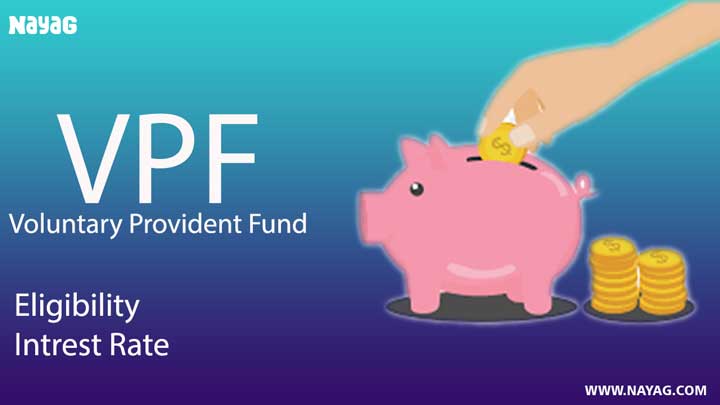If you are looking for a long-term investment option with high returns and low risk factor, you can opt for the Voluntary Provident Fund of VPF. Managed by the Government of India, this scheme offers tax benefits to the applicants.
VPF Information
| Tenure | Up to retirement or resignation |
| Interest rate | 8.5% |
| Investment Amount | Depends on the employee |
| Maturity Amount | Depends on the investment amount |
Voluntary Provident Fund (VPF) is a scheme that comes under the traditional provident fund savings scheme. However, under the VPF scheme, the contributor decides on the amount of fixed contribution that is made towards the scheme on a monthly basis.
- Rate of interest of 8.50% p.a.
- Risks of investing are minimal
- Easy to transfer the amount in case of a job change
- Easy to open a VPF account
Under the VPF (Voluntary Provident Fund) scheme, employees are allowed to make contributions towards their provident fund account on a voluntary basis. The scheme is also called the Voluntary Retirement Fund scheme. The scheme does not include the mandatory 12% that the employee makes towards the Employees’ Provident Fund (EPF).
Employees can contribute up to 100% of their basic salary and dearness allowance towards the scheme. The VPF interest rate is similar to the EPF scheme. It is not mandatory for employers or employees to contribute to the VPF. However, the scheme has a lock-in period of 5 years. The rate of interest of VPF is decided by the Government of India on a yearly basis.
Also Read- PM Schemes List
VPF Eligibility
Since the VPF scheme is an extension of the EPF, only salaried employees who receive payments on a monthly basis in their salary accounts are eligible to invest in the scheme.
Documents required to open a VPF account
The below-mentioned documents must be submitted in order for employees to open a VPF account:
- The company registration certificate with the Ministry of Finance (MoF) must be submitted.
- Form 24 and Form 49 must be submitted.
- In case the organisation is an ‘Sdn Bhd’, the memorandum and articles of association must be submitted.
- The company profile in details must be given.
- The business registration certificate must be submitted.
Employees can check with their employer if any further documents need to be submitted to open a VPF account.
Benefits of VPF
The VPF account comes under the Exempt-Exempt-Exempt (EEE) category. Therefore, employees can enjoy tax benefits and earn a large amount of money in the long-run by investing in the VPF. The main benefits of a VPF account are mentioned below:
- Safe option to invest: Since the scheme is operated by the Indian Government, there are no risks involved in investing in the scheme. Compared to other long-term investment options offered by private organisations, it is very safe to invest in a VPF account.
- High rate of interest: Under the VPF scheme, the rate of interest is 8.50% p.a. The interest that is generated from the contributions is also exempt from tax.
- Application process is easy: The process to open a VPF account is very simple. Employees can contact their employer’s finance team and request them to open a VPF account by submitting the registration form. The current EPF account will act as the VPF account as well.
- Transfer process is simple: In case employees change their jobs, it is very simple for them to transfer the VPF account of the old company to the new one.
Also Read- SSY
Tax benefits available under a VPF
When it comes to various investment options in India, the VPF account is considered among the best. Under Section 80C of the Income Tax Act, 1961, employees are eligible for tax benefits of up to Rs.1.5 lakh. The interest that is generated from these contributions is also exempt from tax. However, in case the rate of interest is more than 9.50% p.a., the amount will be taxable.
Interest rate of a VPF
The rate of interest is set by the Indian Government and is revised on a yearly basis. The rate of interest for FY 2019-2020 is 8.50% p.a. The interest has been decreased from 8.65%, which was the rate of interest previously. Investments towards a VPF account is viable because of its high rate of interest and tax benefits. Given below is the comparison of the PPF and VPF interest rates:
| Financial Year | PPF rate of interest p.a.(%) | VPF rate of interest p.a.(%) |
|---|---|---|
| 2019-2020 | 7.10 | 8.5 |
| 2018-2019 | 7.6 to 8 | 8.65 |
| 2017-2018 | 7.6 to 8 | 8.55 |
| 2016-2017 | 8 to 8.1 | 8.8 |
| 2015-2016 | 8.7 | 8.8 |
| 2014-2015 | 8.7 | 8.75 |
| 2013-2014 | 8.7 | 8.75 |
Also Read- PM Kisan Yojana Status Check
Rules and regulations of a VPF
The rules and regulations of VPF account are mentioned below:
- When compared to an EPF account, employees are allowed to contribute 100% of their basic salary and dearness allowance towards a VPF account.
- It is not compulsory for employees to contribute to a VPF account.
- The Indian Government decides the rate of interest of a VPF account at the start of the financial year. The rate could increase or decrease when compared to previous years.
- The full amount that is available at maturity can be withdrawn at the time of resignation or retirement. Individuals can also transfer their VPF amount from the previous employer to the current one. In case the account holder passes away, the legal heir or the nominee will receive the total amount that has been accumulated.
- Only individuals who work for companies that come under the Employees’ Provident Fund Organization (EPFO) and have an EPF account are eligible to open a VPF account. Individuals who work for unorganized sectors are not allowed to open a VPF account.
- Individuals can open a VPF account at any given time during the financial year. Investments made towards the account cannot be stopped for a period of 5 years.
- Partial withdrawals in the form of loans can be made against the VPF account. In case the amount is withdrawn before the maturity period, the withdrawn sum is taxable.
Also Read-
Process to withdraw money from a VPF account
In case of financial requirements due to medical emergencies, withdrawing money from a VPF account could come in handy. Employees must fill up Form-31 and give a request letter in writing for VPF withdrawal. Employees will be able to get the Form-31 from their employer’s Human Resource (HR) team or on the government’s portal. All required documents, including the details of the employee such as PF number, postal address, and bank details must be submitted. A cancelled cheque must also be submitted. All documents that are submitted must be self-attested.
In case of any unforeseen financial emergencies, employees are allowed to withdraw from the VPF account. Some of the reasons where the VPF can be broken are mentioned below:
- In case medical bills of the account holder or his/her children need to be paid.
- For the marriage or higher-education of the account holder.
- To buy new land or a house or for the construction of the house.
Also Read- Ayushman Bharat Yojana
FAQ’s On VPF
Who are ideal candidates for a VPF account?
Anyone who is looking to invest in a long term financial instrument is an ideal candidate. VPF accounts are best suited for people who are nearing retirement and/or are looking out for a robust, safe and scalable pension fund option.
What is the maximum and minimum amount that can be invested in VPF?
When it comes to investment, there isn’t any maximum or minimum VPF Limit. The same is decided by your individual monthly contributions. You can earmark as much as 100% of your monthly income (salary + dearness allowance) as VPF contribution. Note that your employer isn’t obligated to contribute to your VPF account. Hence, the money accumulated in your voluntary PF account is directly dependent on your monthly contributions and the interest accumulated by the same over the tenure of the investment.
How much amount can I withdraw as loan against my VPF account?
Partial withdrawals are possible as also the complete withdrawal of the monies accumulated in the VPF account. Usually, people who are changing jobs are prone to breaking their voluntary pf accounts and accessing the funds. However, note that if such an action is completed before said account has completed 5 years of existence, the accumulated funds are subject to taxation. NAYAG
What’s the difference between PF, EPF and VPF?
The following table summarizes the differences between these three popular investment types,
PF | EPF | VPF | |
|---|---|---|---|
| Who can open account? | Any Indian (No NRIs) | Employed Indian | Employed Indian |
| Applicable Interest | 8.5% p.a | 8.5% p.a | 8.5% p.a |
| Employee Contribution | N.A | 12% | Upto 100% |
| Employer Contribution | N.A | 12% | N.A |
| Tax on Maturity | None | None | None |
| Tax Benefits | Upto Rs.1 lakh/year | Upto Rs.1 lakh/year | Upto Rs.1 lakh/year |
| Investment Tenure | 15 years | Retirement/ Resignation | Retirement/ Resignation |
| Quantum of Loan | Post 6 years, 50% withdrawal | Can avail partial withdrawals | Can avail partial withdrawals |
We hope you have enjoyed our work, if you liked it Please help us reach more people like You. Share this article with your Friends using below buttons. Sharing is Caring 💗







